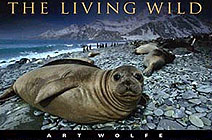|
Art
Wolfe: Through the
Lens: Artistic Adventures in
Alaska
by Wayne Mayer
.jpg) Nature
photographer Art Wolfe thinks
ecotourism is crucial to the
long-term survival of biodiversity.
He should know. Wolfe has explored
hundreds of locations across
every continent to photograph
phenomena that few people would
otherwise get to see. Hundreds
of books and magazines around
the globe carry his images.
Over the last quarter-century,
he has released more than 40
books. His most recent effort,
due out in September, underscores
the value of wildlife, landscapes,
and native peoples. “Ecotourism
brings more people to remote
places like the Tongass forests
in southeast Alaska,”
he says. “The more people
care about these places, the
louder the voice is when species
are threatened; the better the
chance for preservation.” Nature
photographer Art Wolfe thinks
ecotourism is crucial to the
long-term survival of biodiversity.
He should know. Wolfe has explored
hundreds of locations across
every continent to photograph
phenomena that few people would
otherwise get to see. Hundreds
of books and magazines around
the globe carry his images.
Over the last quarter-century,
he has released more than 40
books. His most recent effort,
due out in September, underscores
the value of wildlife, landscapes,
and native peoples. “Ecotourism
brings more people to remote
places like the Tongass forests
in southeast Alaska,”
he says. “The more people
care about these places, the
louder the voice is when species
are threatened; the better the
chance for preservation.”
 “Sure,”
Wolfe acknowledges, “there
is concern that too many people
stress these fragile rainforests
and tundra, but the benefits
of tourism outweigh the stresses.”
Natural history cruises play
a critical role in protecting
threatened environments, both
by public outcry and economic
input. “If a town in southeast
Alaska makes more money from
tourism than from logs or fish,
the community’s economy
evolves towards conservation.” “Sure,”
Wolfe acknowledges, “there
is concern that too many people
stress these fragile rainforests
and tundra, but the benefits
of tourism outweigh the stresses.”
Natural history cruises play
a critical role in protecting
threatened environments, both
by public outcry and economic
input. “If a town in southeast
Alaska makes more money from
tourism than from logs or fish,
the community’s economy
evolves towards conservation.”
Wolfe has often traveled on
small ships, especially during
his voyages to Alaska. “You’re
able to get off the ships and
out to the animals,” he
explains. Natural history tours
arrange off-ship excursions
in Zodiacs. The ship might shuttle
passengers to the Tongass National
Forest or close to a pod of
humpback whales. The tours are
both personal and educational.
Smaller boats are also lower
in the water and offer better
angles for photography.
Wolfe draws on his twenty-five-year
career to offer some insights
into getting that great wildlife
shot. “When approaching
subjects,” he says, “pay
attention to the animals. Move
slowly and quietly. Do not surround
them; always allow animals plenty
of room to move. If animals
feel stressed, they leave and
you don’t get good photos.”
In general, Wolfe recommends
films with speeds of 100 or
200 that can be pushed to faster
speeds if necessary, based on
light conditions. Higher film
speeds allow you to “freeze
motion,” an important
consideration when shooting
from a boat. In southeast Alaska,
Wolfe suggests faster film and
a tripod because of the gray
weather.
Lenses with image stabilizers
are great on deck because they
counteract a ship’s rocking
motion. In the forest, use a
tripod to hold your equipment
steady in low-light environments.
His favorite lens for southeast
Alaska is an 80–200 mm
zoom with a 1.4 extender so
that the range stretches to
280 mm. “You can capture
humpback whales with an 80–200
mm zoom and ASA 200 film,”
says Wolfe. To click shots of
black and brown bears on shore,
he recommends a 600 mm lens
and a 1.4 extender. “The
long lens is almost mandatory
to safely photograph bears in
the wild. Besides, in Alaska’s
fjords you can’t get close
to bald eagles, but with a 600
mm lens and a tripod, you can
capture an eagle’s power
and beauty from the deck of
a ship.”
Summarizes Wolfe, “small
ships provide excellent ways
to see sea lions, seals, whales,
eagles, bears, caribou, reindeer,
millions of shore birds, take
pictures, and come away from
the experience understanding
the importance of wildlife conservation.”
Footnote: When he’s not
exploring the Earth’s
farthest reaches, Art Wolfe
resides in Seattle, Washington,
and gives lectures and multimedia
presentations about his travels.
Art Wolfe’s captivating
images have appeared in hundreds
of magazines and books around
the world. Since his debut in
1978, Wolfe has released 41
books and he has 12 more in
preparation including The Living
Wild, which will be released
in September. For more information
about The Living Wild, log on
to www.WildlandsPress.com. To
learn more about Art Wolfe and
his photography, visit www.ArtWolfe.com.
|

